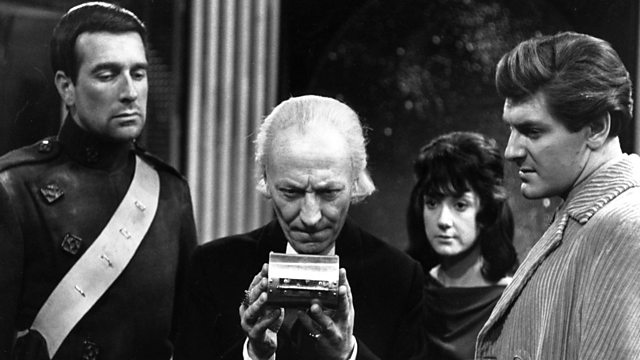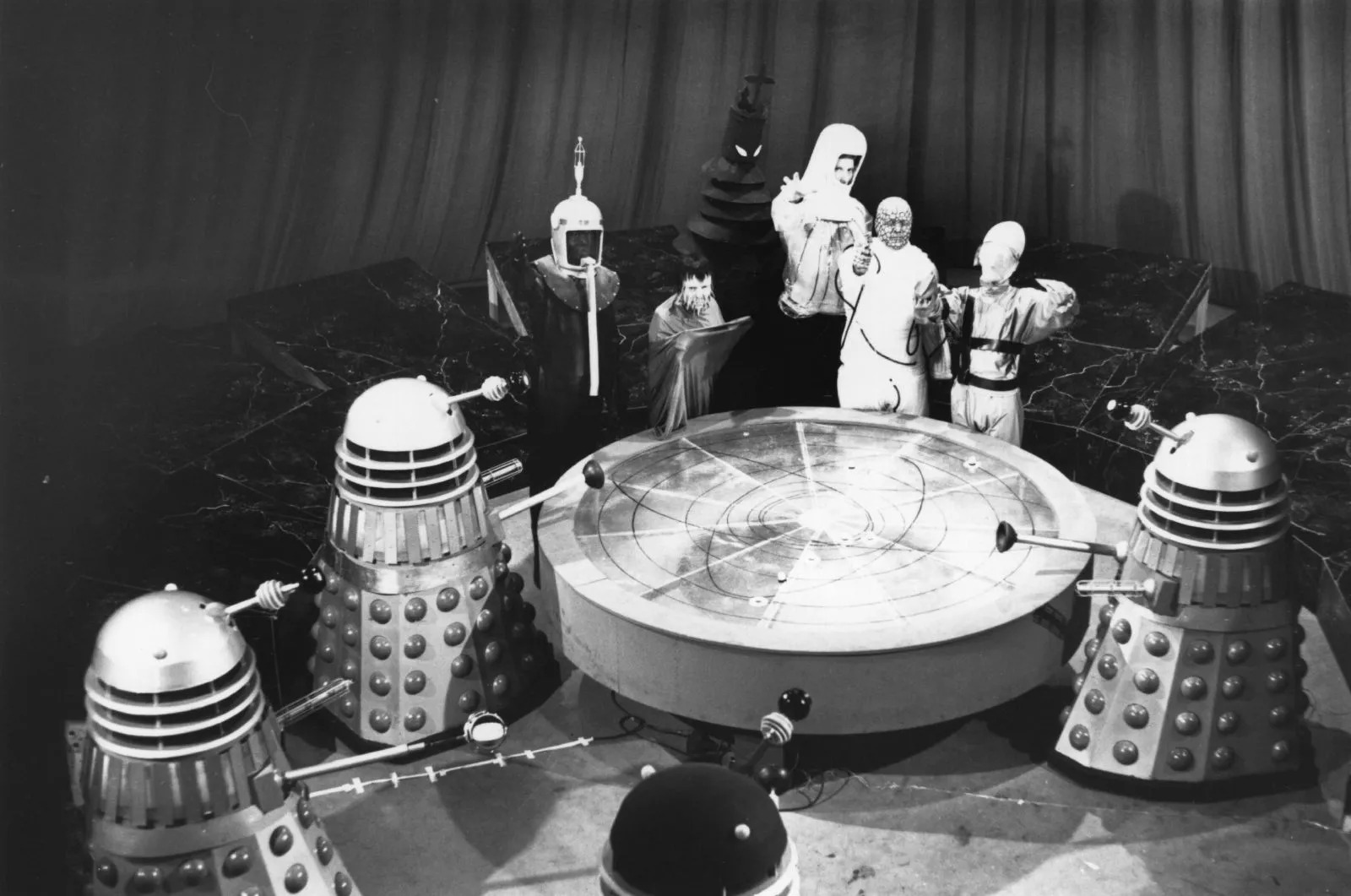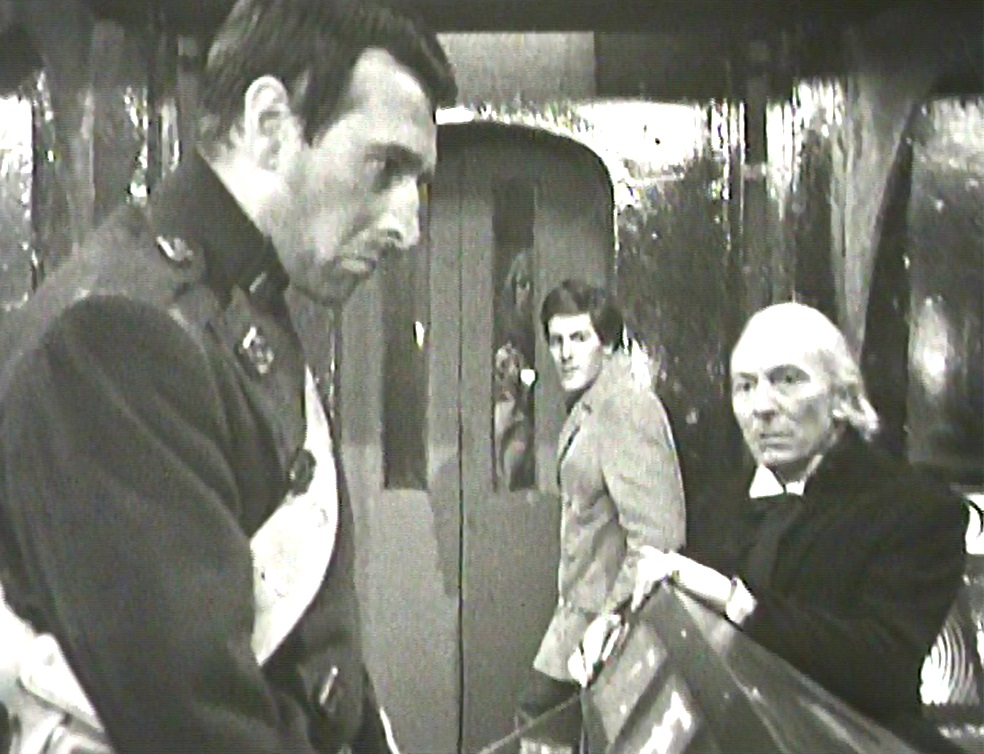DOCTOR WHO, SEASON 3 SERIAL 3:
NIGHTMARE ON PLANET KEMBEL
Doctor: First (William Hartnell)
Companions: Steven, Katarina
May 2023

Nightmare on Planet Kembel is an unofficial designation of five episodes into a story created by yours truly. It comprises what is popularly known as the first four episodes of The Daleks' Master Plan, as well as Mission to the Unknown. Its five parts are, in order:
- Mission to the Unknown
- The Nightmare Begins
- Day of Armageddon
- Devil's Planet
- The Traitors
Let’s talk about serialization.
So a story that is or has been serialized (if you’re unfamiliar with the term) is a story that is broken up and told in a series of chunks, delivered one at a time and often over a long period. Many modern TV shows (like Stranger Things or Breaking Bad) tell serialized stories, and the format sticks with serialization quite well, although there’s been more of a shift to tell more direct stories where each part is a necessary one rather than a TV show where you could tune in any one week and not miss anything too large. That is, episodic storytelling, wherein each story is largely self-contained (possibly with occasional throughlines, but not as the main focus): look at most sitcoms, for example. Or modern Doctor Who. Serialization as a format is not limited to television: Charles Dickens’ novels were famously serialized in newspapers before being eventually collected into bound volumes, and the same is true of (for instance) Sherlock Holmes. For a more modern example, a lot of fanfiction is presented in a serialized format, chapters being uploaded to the website of choice when they’re completed, usually one at a time. Serialization has a lot of benefits: for example, audience retention and allowance of the art to remain present in your head for a long period of time. With Doctor Who’s regular cliffhangers, for example, the audience waits, wondering for a full week—what will happen next? For this reason, I highly recommend (once again doing what Elizabeth Sandifer recommends) never watching more than one episode of this show in succession. Leave a significant break: go do something else, then come back and watch another, even days later. It makes the subsequent episodes that much more impactful, and the story more effective overall. It also helps keep from feeling like stories are dragging too much, in my experience: what feels interminable becomes..uh...terminable with ease when broken up into 22-minute segments.
While all of the original TV run of Doctor Who is serialized (except The Five Doctors, which was a triple-length anniversary special), most of it is subdivided into larger “stories”, which I’ve been writing reviews of: The Horror of Fang Rock is essentially set in the same narrative time as The Robots of Death, because at the beginning and end of each Leela and the Doctor get out of the TARDIS in a new and different place and at the end they get back on and leave again. This is fine and cool—but it was not always the case.
The Doctor Who that was aired between (at the very least) 1963 and late May 1966 was not subdivided into these stories, at least not from a viewer’s perspective. I’ve been reviewing stories like “Galaxy 4” on this blog, but really what we call “Galaxy 4” was just the span of time taken up by the four episodes “Four Hundred Dawns,” “Trap of Steel,” “Air Lock,” and “The Exploding Planet,” and that last one was immediately followed by “Mission to the Unknown”, which was subsequently followed immediately by “Temple of Secrets”. Do you get what I’m saying? It’s all one big story. Granted, it’s not a story in the modern sense, in the same way Breaking Bad is—there aren’t overarching character arcs, for example—but it’s not neatly divided in the way we often claim it to be. This is becoming a problem for me, specifically, because I decided to review these things on a story by story basis, and Season 3 is where that breaks down.
In common parlance, Season 3 of Doctor Who has 10 stories in it: the first four are Galaxy 4 (4 episodes), Mission to the Unknown (1 episode), The Myth Makers (4 episodes), and The Daleks’ Master Plan (12 episodes). But frankly, this doesn’t really work. For one thing, Mission to the Unknown is essentially a prologue to The Daleks’ Master Plan, which only follows it after four episodes of basically unrelated historical. And for another, there is a strong narrative undercurrent running through mostly those last five episodes (though it technically begins in Galaxy 4): at the end of Galaxy 4, Vicki hurts her ankle. This injury is a plot point throughout The Myth Makers; at the end of The Myth Makers, Steven is injured and poisoned: this bleeds directly into the beginning of The Daleks’ Master Plan, which of course follows directly on from Mission to the Unknown.
All this to say that basically the modern framing of this early show doesn’t really work. Furthermore, I’m not even going to be looking at The Daleks’ Master Plan in this review: I’m only going to talk about the first five episodes (including Mission to the Unknown). I’ll call it...I don’t know. Nightmare on Planet Kembel. Why not.

So after that lengthy prologue, how is this story? Well! Really fucking good!
Legitimately this is some of the best Doctor Who we’ve ever seen up to this point. I might go so far as to say that, even despite 4/5ths of it being missing and 3/5ths being unwatchable in motion, this is the best Doctor Who story so far in its 3-year history. This is the Dalek story, the lost epic, to which all other Dalek stoies (thus far) are but a pale shadow. The only reason why we talk more about The Dalek Invasion of Earth is because that one’s feature-complete while this one’s 75% missing (or at least, that’s my opinion). This is “Dalekmania”. This is the big one, the grand scope full-scale universal Dalek invasion of everything, everywhere. And at least thus far, it fully deserves that title.
Before watching it, I was unsure about the fact that Mission to the Unknown is a full four parts ahead of the rest: it feels awkward, sort of stilted, and it certainly gives you some narrative whiplash when watching. But I’m actually going to defend it here. Mission to the Unknown is, in effect, a Doctor Who story where the Doctor never shows up to save the day. The world is lost, our heroes perish without help, and the Daleks are set to take over the universe.
This then becomes a wild premise when, in The Nightmare Begins (four episodes after that’s sat in our head without becoming relevant), the same thing happens again: Space Security Agent Bret Vyon and his injured pal are lost in the jungles of Kembel and fearing the deadly Varga plants, just like Marc Cory was four weeks ago (from an audience perspective). Except, this time...the TARDIS shows up. And this becomes a twist, for an audience who’s had four weeks of Mission to the Unknown in the back of their heads! And then the Doctor doesn’t help!
I really can’t stress enough how much tension there is in that first episode, The Nightmare Begins, because it’s desperately obvious that the Doctor is in a very different episode than Bret Vyon. The Doctor is in a story like The Romans, where sure, there are tensions and dangers (he’s gotta get an antidote for Steven!), but largely he’s focused on heading out to the city to find that. Bret, meanwhile, is on his last legs trying to get off of this Dalek-infested planet and doesn’t care who he has to threaten to do it. The first episode is really brilliant, even solely in reconstructions, because of this tension between what the characters are trying to make the story out to be. And because they’re at loggerheads like this, the Doctor doesn’t even find out that there are Daleks involved until like! Halfway through the episode at least!
This tension sticks around throughout all of these episodes, even growing throughout them as things happen. Episode 3 (or 2), Day of Armageddon, which is conveniently still in the archives, is absolutely phenomenal. I love it. It’s a strong contender for my favorite episode with the First Doctor ever, it’s that good, and even if you don’t want to watch the rest of this story (which I still highly recommend), I recommend you watch this episode alone (assuming you can get past what I mention later). It’s truly wonderful.

I’ve made my opinion on these parts very clear by now, I think, (Very Good I Like It A Lot), and I haven’t even touched on Bret Vyon! (He’s played by Nicholas Courtney, better known for being the Brigadier, as his first Doctor Who role and is brilliant.) But that’s not to say that this serial doesn’t have its issues. Let’s talk about Mavic Chen.
Now, by this point in the show’s history (and in my reviews), Doctor Who has had its...encounters with blackface and yellowface. It’s a racist and cringeworthy technique that serves to demean people of color, playing caricatures and perpetuating stereotypes, like we’ve seen in Marco Polo, The Aztecs, and The Crusade—not to mention the chronologically later Talons of Weng-Chiang. When I first realized that the role of Mavic Chen would be played by Kevin Stoney—notably, a very white man—in race makeup, I was...displeased, to say the least. I was expecting the worst. And don’t get me wrong: the fact that they made this choice about how to cast and write the role of the betrayer of the solar system is unequivocally very much a bad thing!! But I find myself falling back on the old “I suppose it could have been worse.” Because let’s be clear here: Kevin Stoney is somehow sort of doing blackface and yellowface at the same time (playing a character with dark face paint and white hair, a mustache and goatee, eyebrows that slope cartoonishly downwards, and a traditionally Chinese last name), which, to be clear, is terrible flat-out. Yet he’s not doing the same sort of cultural caricature that, say, John Bennett performs in Talons, where he puts on a strong (and offensive) accent, is explicitly Chinese, tapes his eyelids, and is set in a story with an intensely strong anti-Chinese lean. Kevin Stoney speaks in his natural voice, and, at least in these four episodes he appears in so far, no reference has been made to his ethnicity at all.
It all lends a very strange sort of datedness to the story, where it almost feels like this was an attempt at diversity? Look at the future, we have Mavic Chen, he’s not white and he’s the Guardian of the Solar System! But if it’s trying to do that, it fails, because despite being the only nominally non-white character, he also is the one who betrays humanity and sides with the Daleks. There’s nothing in the way that he’s written or even performed that relies on the blackface of his physical portrayal: it’s a sole bitter slice of lemon, rind and all, inserted into the birthday cake of this story. Perhaps that’s a belabored metaphor, but it’s very strange in some ways how entirely contained this element of dated racism is. I think that needs to be said. If you don’t feel that you can look past that (and I would not blame you in the slightest: it’s a tall order to look past, to say the least), then I’d recommend against watching this serial. But for me, I approach it the same way I do when rereading, say, Lord of the Rings: is it racist? Yes! Does it have racist elements? Absolutely! (If you’re not familiar, the Southrons and Easterlings are dark-skinned peoples who immediately side with Sauron and aren’t remarked upon much more than that.) And that must be stated and must be known to move forward. But I can enjoy the other elements of the story while noting that.
Moving to some of the other elements of the story, let’s talk about some spoilers, because there are some wild twists in the last episode:
First, Katarina. Katarina is an interesting companion, because she was written to die. In Terry Nation’s original script for this story, Vicki would have died in “The Traitors”, and I for one am extremely glad we avoided that reality. She deserves better as a character. But since she got written out in the last story, Katarina had to be hastily written in to fulfill her role in this one. Which...
Hang on, what? Katarina made one contribution to the plot: she gave Steven the pills from Bret’s pouch to heal him in episode one. Obviously, her death scene adds a notable sequence to the story, but what does it add in regards to the plot? Nothing, apart from resolving a plot point that was only introduced half an episode ago: the convicts on the convict planet (an underwhelming plot point anyways). I’m not going to lie to you: the role could have been entirely cut and it wouldn’t have changed much at all. I mean, I like Katarina! In the little we see of her, she’s friendly, kind, and views the TARDIS and everything she’s been interacting with in a fascinating theological light. But she’s given basically nothing to do by the plot, which big sucks when you consider she’s only a companion for four episodes.
I am very fond of the team we have for this story: that is, the Doctor, Steven, Katarina, and Bret. They all play off each other in cool and funny ways, and I sort of wish we got more of them—especially Katarina, obviously. Bret is a very fun character, because he strikes something of a balance between the “James Bond-type” of Marc Cory from the last story and a more frantic, harried personality like we often see from Steven. He’s not as cool as Marc! But he knows the terrain here, and he’s interestingly pragmatic, which allows for some strong interpersonal dynamics. Also, he’s played by Nicholas Courtney, which is obviously a huge win. Big ups to Courtney for all of his acting roles.
Katarina’s death scene is very fast, but luckily it’s one of the surviving clips from the story (this story has a lot of surviving clips in it. The next one does not) which allows it a bit more gravitas. And the Doctor’s speech afterwards is simply brilliant and frankly extremely touching: the emotion Hartnell can carry, even through audio alone, is powerful. I nearly teared up. The choice from Loose Cannon to have a CG render of Katarina’s body floating through space...a bit less so. It’s just goofy. It adds nothing to the story and doesn’t look good—it just takes you out of it.
The choice to have Bret Vyon die at the end of The Traitors also ups the stakes fantastically. We’ve spent four episodes getting to know this guy and he’s offed in a matter of seconds by Sara Kingdom, who’s now hunting down our heroes for the taranium they hold. (Side note: I love that they keep making up more fake macguffin metals in this show. A full M of taranium!) It’s a strong way of making it clear just how scary the foes that our heroes (now shrunk to just the Doctor and Steven) are up against now: by the end of episode 5, half our heroic cast is dead, and our remaining heroes have barely escaped with their lives. Not to mention Mavic Chen has turned everyone else against them. It’s so good. It’s also a large part as to why I decided to break and write a review here, because it feels like a strong stopping point.
Overall thoughts:
While it doesn’t provide a full story, Nightmare on Planet Kembel (I like that name. If I come up with a better one I’ll change it, but I like it) is still perhaps the strongest offering Doctor Who has had in all its three seasons so far, even despite its mostly-missing format. I highly recommend it, if you can stomach the portrayal of Mavic Chen, a weirdly permissible character despite his racialized appearance (at least for me). If not, that’s completely understandable. If you want a different large-scale Dalek story I’d recommend The Dalek Invasion of Earth or perhaps The Chase (for something lighter). It’s a “grittier” Dalek story and it pulls that off very well. Don’t watch it if you can’t stand the reconstructed format or the visuals of Mavic Chen. For me, though, this story has blown the season’s other offerings out of the water - though watching from Mission to the Unknown all the way through to here isn’t a bad time at all, and is frankly great to do.
Next time, I’ll be looking at the next part of this Dalek saga—word’s still out on how many episodes that’ll be, but I suspect in the range of four or maybe five again. I’ll probably come up with a fun name again, too!
(Oh, and also a companion retrospective on Katarina! A lot of that will be the same stuff that was in here.)